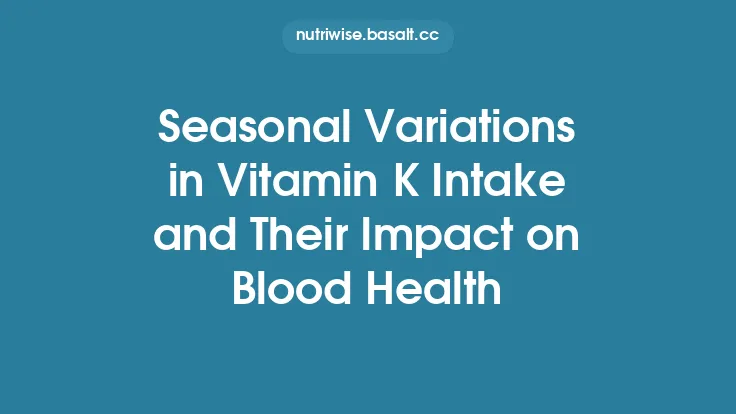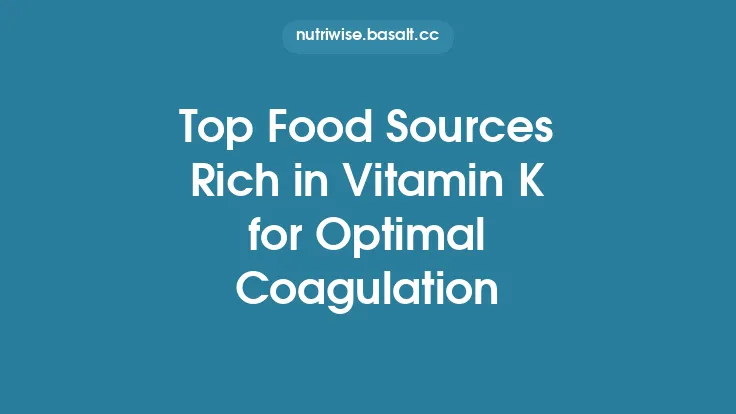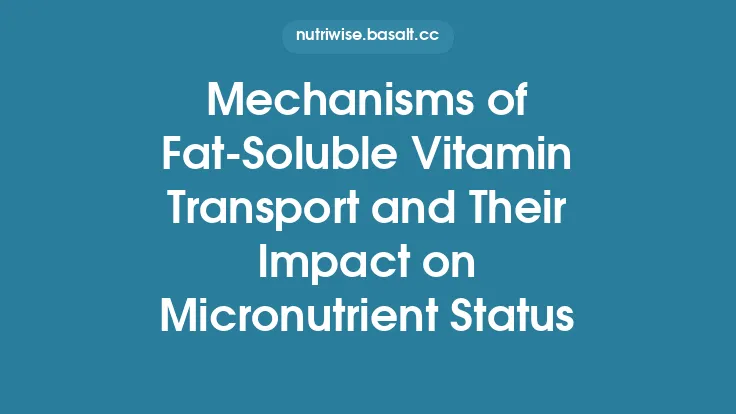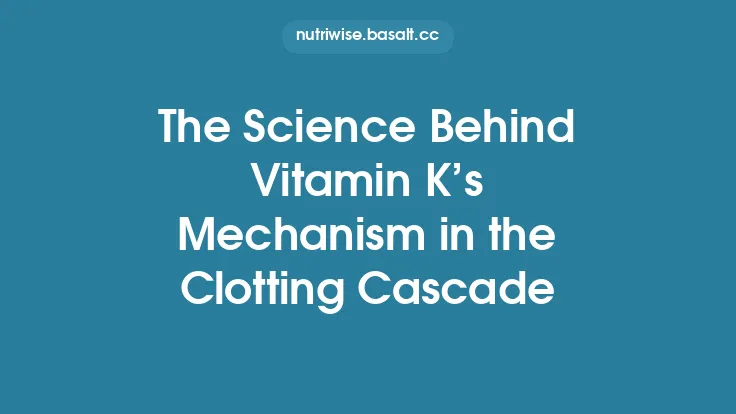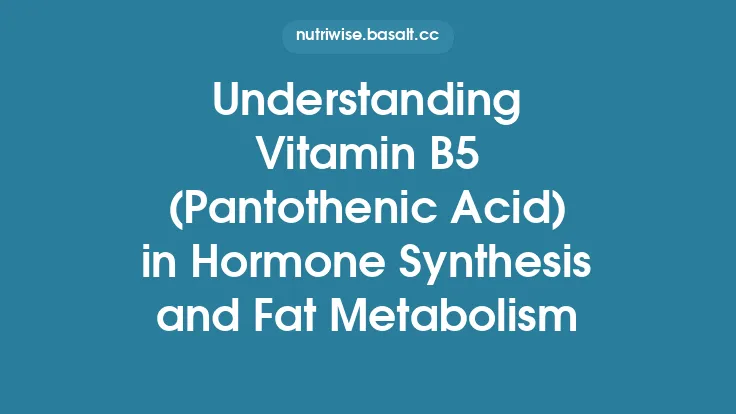Vitamin K is not a single compound but a family of structurally related molecules that share a common quinone core yet differ in side‑chain length, saturation, and origin. These variations give rise to distinct pharmacokinetic behaviors, tissue distribution patterns, and, importantly, nuanced contributions to the cascade of events that culminate in blood clot formation. Understanding how each vitamin K type participates in coagulation helps clinicians, researchers, and health‑conscious readers appreciate why a balanced intake of the different forms matters for optimal hemostasis.
Overview of Vitamin K Forms
The vitamin K family is traditionally divided into three major groups:
| Group | Common Name | Chemical Structure | Primary Sources | Key Distinguishing Feature |
|---|---|---|---|---|
| K1 | Phylloquinone | A 2‑methyl‑1,4‑naphthoquinone ring with a phytyl side chain (C20) | Green leafy vegetables, certain plant oils | Plant‑derived; short side chain |
| K2 | Menaquinones | Same quinone core, but with a polyisoprenoid side chain of varying length (MK‑4 to MK‑13) | Fermented foods, animal products, gut microbiota synthesis | Variable side‑chain length; both dietary and bacterial origin |
| K3–K5 | Synthetic or minor natural variants (menadione, menadiol, etc.) | Simplified quinone structures lacking the phytyl or isoprenoid side chain | Industrial synthesis, some animal tissues | Generally water‑soluble; limited physiological relevance in humans |
While K1 and K2 dominate human nutrition, the synthetic analogues (K3–K5) have historically been used in research and, in some regions, as animal feed additives. Their role in human coagulation is minimal under normal dietary conditions, but they provide valuable mechanistic clues about the quinone backbone’s function.
Phylloquinone (Vitamin K1) – The Hepatic Workhorse
Phylloquinone is the most abundant vitamin K form in the typical Western diet. After intestinal absorption, it is packaged into chylomicrons, enters the lymphatic system, and is preferentially taken up by the liver via the low‑density lipoprotein (LDL) receptor pathway. Within hepatocytes, K1 serves as the primary cofactor for the γ‑glutamyl carboxylase (GGCX) enzyme that activates the clotting factors II (prothrombin), VII, IX, and X, as well as the anticoagulant proteins C and S.
Key characteristics of K1 in the coagulation context:
- Rapid hepatic clearance: The hepatic half‑life of K1 is approximately 1–2 hours, ensuring a steady supply for continuous synthesis of clotting factors.
- High affinity for GGCX: K1’s phytyl side chain fits snugly into the enzyme’s hydrophobic pocket, promoting efficient electron transfer during the carboxylation reaction.
- Limited extra‑hepatic activity: Because K1 is quickly sequestered by the liver, only a modest fraction reaches peripheral tissues, making its direct contribution to extra‑hepatic γ‑carboxylation (e.g., of matrix Gla‑protein) relatively minor.
Thus, K1 can be viewed as the “first‑line” vitamin K for maintaining the baseline production of the coagulation cascade’s essential proteins.
Menaquinones (Vitamin K2) – A Spectrum of Side‑Chain Lengths
Menaquinones are distinguished by the number of isoprenoid units (denoted as MK‑n, where *n* indicates the number of units). The most studied variants are MK‑4 (four isoprenoid units) and MK‑7 (seven units), but longer chains up to MK‑13 have been identified, especially in fermented foods and bacterial cultures.
MK‑4
- Origin: Although present in some animal tissues, the majority of MK‑4 in humans is generated endogenously from K1 via a tissue‑specific conversion pathway that involves removal of the phytyl side chain and addition of a geranylgeranyl group.
- Distribution: MK‑4 is found in the pancreas, arterial walls, and, importantly, in the liver at concentrations comparable to K1.
- Coagulation role: Because MK‑4 can be taken up by hepatocytes, it contributes directly to the γ‑carboxylation of clotting factors. Experimental data suggest that MK‑4 may sustain hepatic vitamin K activity during periods of low dietary K1 intake, acting as a “reserve” form.
MK‑7 and Longer Menaquinones
- Absorption and transport: The longer isoprenoid side chains confer greater lipophilicity, resulting in slower intestinal absorption but prolonged circulation time (half‑life up to 72 hours for MK‑7). These forms are primarily transported in the bloodstream bound to high‑density lipoprotein (HDL) particles.
- Extra‑hepatic emphasis: The extended half‑life allows MK‑7 to reach peripheral tissues more effectively than K1 or MK‑4. While this extra‑hepatic distribution is often highlighted in the context of bone and vascular health, it also means that a fraction of MK‑7 remains available to the liver for clotting factor activation, especially when hepatic K1 stores are depleted.
- Synergistic effect: Studies using isolated hepatocyte cultures have demonstrated that co‑administration of MK‑7 with K1 can enhance overall γ‑carboxylase activity, suggesting that different menaquinones may act cooperatively rather than competitively.
Comparative Summary
| Property | K1 (Phylloquinone) | MK‑4 | MK‑7 (and longer) |
|---|---|---|---|
| Primary source | Plants | Endogenous conversion & animal tissue | Fermented foods, gut bacteria |
| Absorption efficiency | High (micelles) | Moderate | Lower, but compensated by longer half‑life |
| Circulating half‑life | 1–2 h | 4–6 h | 48–72 h |
| Hepatic uptake | Strong | Strong | Moderate |
| Extra‑hepatic presence | Low | Moderate | High |
| Contribution to clotting factor carboxylation | Primary | Supplemental/backup | Supplemental, especially during low K1 intake |
Synthetic and Minor Forms (Vitamin K3, K4, K5) – Limited but Insightful
Synthetic analogues such as menadione (K3) and its reduced form menadiol (K4) lack the long side chain that characterizes natural vitamin K. Because they are more water‑soluble, they can cross cellular membranes without the need for lipoprotein carriers. In vitro, K3 can serve as a substrate for GGCX after intracellular reduction to the hydroquinone form, but its rapid metabolism and potential for oxidative stress limit its physiological relevance.
- K3 (Menadione): Historically used in animal feed, K3 can be converted to active vitamin K within the liver, but high doses are associated with hemolytic anemia and hepatic toxicity. Consequently, its contribution to human coagulation is negligible under normal dietary conditions.
- K5 (2‑Methyl‑1,4‑naphthoquinone): Identified in certain fungi, K5 exhibits weak activity in γ‑carboxylation assays and is not considered a significant source of functional vitamin K for hemostasis.
These synthetic forms are primarily of interest for experimental manipulation of the vitamin K cycle rather than for nutritional or therapeutic purposes.
Comparative Bioavailability and Kinetic Profiles
Understanding the kinetic behavior of each vitamin K type clarifies why they differ in their impact on coagulation:
- Absorption Pathways: K1 utilizes the classic micelle‑mediated absorption in the small intestine, whereas longer menaquinones rely more heavily on chylomicron formation and subsequent lymphatic transport. The efficiency of these pathways determines the amount of vitamin reaching the liver within a given timeframe.
- Transport Mechanisms: Post‑absorptive transport of K1 is dominated by LDL particles, aligning with the liver’s preference for LDL receptors. MK‑7’s affinity for HDL facilitates a broader tissue distribution, but also means a slower delivery to hepatic GGCX.
- Storage and Recycling: The liver stores K1 in hepatic microsomes, where it can be recycled via the vitamin K epoxide reductase (VKOR) system. Menaquinones, especially MK‑4, are also subject to recycling but may be preferentially retained in extra‑hepatic membranes, influencing the balance between clotting and extra‑hepatic γ‑carboxylation processes.
- Half‑Life Implications: A short half‑life (K1) ensures rapid turnover, which is advantageous for acute regulation of clotting factor synthesis. Conversely, a long half‑life (MK‑7) provides a steadier, low‑grade supply that can sustain hepatic function during periods of dietary fluctuation.
These kinetic distinctions underscore why a mixed intake of K1 and K2 can provide both immediate and sustained support for the coagulation cascade.
Specific Contributions to Coagulation Factor Carboxylation
The γ‑carboxylation of glutamic acid residues on clotting factors is a vitamin K‑dependent post‑translational modification that enables calcium binding, a prerequisite for membrane localization and enzymatic activity. While the biochemical steps are identical regardless of the vitamin K source, the efficiency and timing of factor activation can vary with the type present:
- Factor II (Prothrombin): Rapidly synthesized in the liver; its carboxylation is highly sensitive to fluctuations in K1 levels due to the enzyme’s high Km for the quinone cofactor.
- Factor VII: Has a relatively short plasma half‑life (≈6 h) and is often the first to reflect changes in hepatic vitamin K status. Both K1 and MK‑4 can maintain its carboxylation, but MK‑7’s slower delivery may be insufficient during acute demand.
- Factor IX and X: Their longer plasma half‑lives (≈24 h and 40 h, respectively) allow a broader window for carboxylation, making them more tolerant of mixed vitamin K sources.
- Proteins C and S: As natural anticoagulants, their activation mirrors that of the pro‑coagulant factors. Adequate hepatic K1 ensures balanced anticoagulant activity; however, MK‑4 can partially compensate when K1 is limited.
Experimental models using vitamin K‑deficient rats repleted with isolated K1, MK‑4, or MK‑7 have demonstrated that while all three can restore clotting factor activity, the dose‑response curves differ. K1 achieves 50 % maximal activity at lower concentrations, whereas MK‑7 requires higher molar amounts to reach the same level, reflecting its lower hepatic affinity.
Clinical Implications of Type‑Specific Deficiencies
Although overt vitamin K deficiency is rare in well‑nutrioned populations, selective deficits in particular forms can arise under specific circumstances:
- Malabsorption syndromes (e.g., cholestasis, celiac disease) impair the absorption of the more lipophilic menaquinones, potentially reducing MK‑7 availability while K1 absorption remains relatively preserved.
- Broad‑spectrum antibiotic therapy can suppress gut microbiota that synthesize long‑chain menaquinones, leading to a transient decline in circulating MK‑4/MK‑7 levels. This may subtly affect hepatic vitamin K reserves during prolonged treatment.
- Genetic variations in the VKORC1 or GGCX genes can alter the enzyme’s affinity for different quinone forms, making some individuals more reliant on one type over another for optimal clotting factor activation.
In such contexts, clinicians may consider monitoring not just total vitamin K status but also the relative proportions of K1 versus K2, especially when evaluating unexplained coagulopathies.
Research Directions and Emerging Insights
The field continues to explore nuanced aspects of vitamin K biology that could refine our understanding of coagulation:
- Transporter Identification: Recent proteomic studies suggest the existence of a dedicated hepatic menaquinone transporter distinct from the LDL receptor, which may preferentially import MK‑4. Elucidating this pathway could explain inter‑individual variability in K2 utilization.
- Isoform‑Specific Enzyme Kinetics: Advanced kinetic modeling of GGCX with different quinone substrates is revealing subtle differences in catalytic turnover (k_cat) and substrate affinity (K_m), potentially informing the design of targeted vitamin K analogues for therapeutic modulation of clotting.
- Microbiome‑Derived K2 Quantification: Metagenomic sequencing coupled with mass spectrometry is enabling precise measurement of gut‑derived MK‑n species, opening avenues to assess how dietary patterns or probiotic interventions influence hepatic vitamin K pools.
- Cross‑Talk with Lipid Metabolism: Because vitamin K is carried on lipoproteins, alterations in lipid profiles (e.g., hypercholesterolemia) may affect the delivery of K1 versus K2 to the liver, thereby indirectly modulating coagulation factor synthesis.
These investigative threads promise to deepen the granularity with which we can link specific vitamin K types to hemostatic outcomes.
Summary
Vitamin K’s role in blood coagulation is not monolithic; it is a composite of several chemically distinct forms, each with its own absorption dynamics, transport preferences, tissue distribution, and kinetic behavior. Phylloquinone (K1) serves as the primary, rapidly turned‑over hepatic cofactor that sustains the continuous production of clotting factors. Menaquinones (K2), especially MK‑4 and MK‑7, act as complementary sources—MK‑4 can be generated from K1 and supports hepatic function, while longer‑chain MK‑7 provides a prolonged, extra‑hepatic reservoir that can back‑fill hepatic needs during periods of low K1 intake. Synthetic analogues like K3 have limited physiological relevance but remain valuable research tools.
Recognizing these distinctions helps explain why mixed dietary sources of vitamin K are advantageous for maintaining robust hemostasis, and it underscores the importance of considering both quantity and form when evaluating vitamin K status in clinical or research settings.
